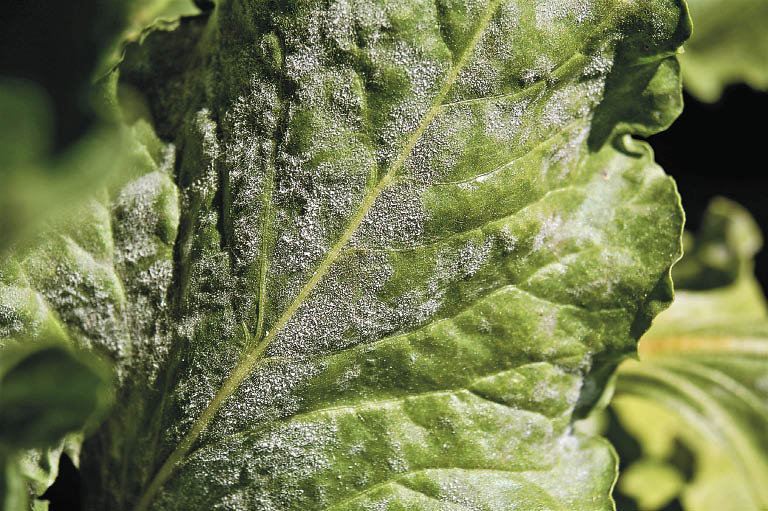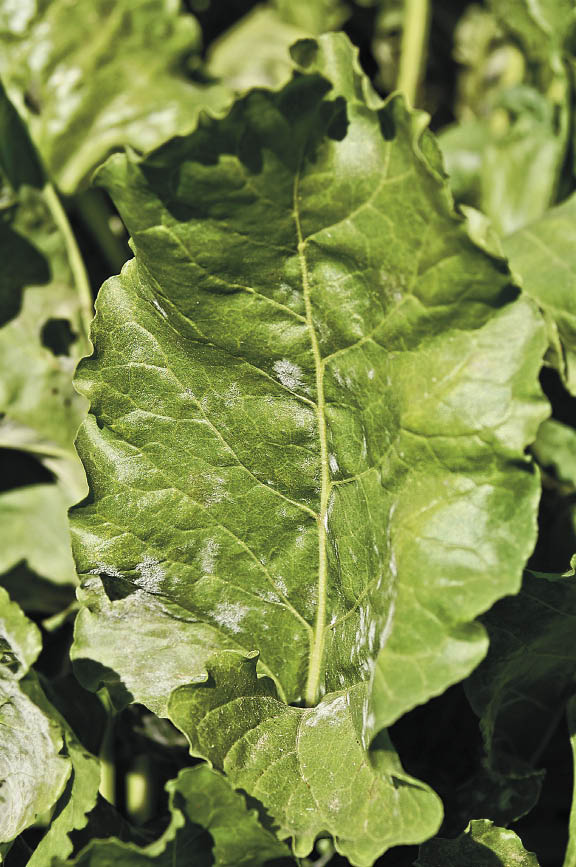
It commonly first appears as a white, cotton-like substance on lower sugarbeet leaves before spreading.
Sugarbeet growers saw it last year. They know that it's going to be back this year, and they're certain it'll return next year.
The soft, white fibers-signs of a fungal disease called powdery mildew-are an annual issue for Pacific Northwest and Plains sugarbeet producers. While the disease can cause sugar yield reduction, it can be quite manageable if detected early enough. Through proper scouting, sound cultural practices and timely crop protection applications, sugarbeet growers can defeat this annual disease from the start.
Watch for signs of mildew
Powdery mildew is an airborne fungal pathogen that typically infects sugarbeet crops in the heat of the growing season. It thrives under high relative humidity with highly fluctuating day-to-night temperatures after the crop canopies and row closure is achieved.
"Powdery mildew can be very bad for Colorado and Nebraska sugarbeet growers. It normally starts to show after long periods of warm days and cool nights with high humidity," said James Marlatt, a Nebraska-based agronomic service representative for Syngenta. "In our area, symptoms show up in late July or early August. I tell my growers if they really see big swings in daytime and nighttime temperatures, it's time to look for powdery mildew."
In the Pacific Northwest, powdery mildew can infect fields a little earlier, explained Glenn Letendre, an Idaho-based agronomic service representative at Syngenta.
"The western part of Idaho can see powdery mildew as early as the middle of July, while it's normal for the eastern portion of the state to see it in early August," he said.
An airborne pathogen, powdery mildew travels and disperses via winds. The disease is invisible to the naked eye in the early stages of infection, but as it spreads over the plant, the distinctive white, cotton-like fibrous spots begin to appear on the underside of lower leaves. Severely infected fields will look as if crop foliage was covered in a white dust.
Most affected plants live with the disease, and powdery mildew will not cause stand reduction or affect plant growth, said Oliver T. Neher, plant pathologist at University of Idaho. However, he warns not to be tricked by appearances because diseased plants produce less sugar yield.
"Powdery mildew shuts down photosynthesis and takes energy away that would otherwise be used to produce sugar," Neher said. "When leaves are covered in powdery mildew, they are unable to perform active photosynthesis. Growers can still see a large number of sugarbeet plants, but sugar content will be reduced."
According to Neher, heavily infected fields can lose up to 35 percent sugar content under the right environmental conditions. While powdery mildew can be devastating, it is also a disease that can be controlled with a management plan that includes cultural practices and timely fungicide applications.
Thwart powdery mildew with moisture management and seed variety
 Managing soil moisture is one way to help reduce the impact of powdery mildew infestations. The disease thrives in wetter conditions, which makes management difficult under furrow irrigation systems like those in Idaho.
Managing soil moisture is one way to help reduce the impact of powdery mildew infestations. The disease thrives in wetter conditions, which makes management difficult under furrow irrigation systems like those in Idaho.
"The western part of Idaho has a warmer climate, and growers tend to use furrow irrigation, which creates a warm, moist environment conducive for powdery mildew activity," Neher said. "On the other side of the state, temperatures are usually cooler and growers tend to use overhead irrigation, which can wash away the pathogen's spores."
Neher added that growers should try to avoid over and under irrigation and should target an optimum moisture level for their crop to avoid stress. To determine optimum moisture levels, contact a local extension office or crop consultant.
Growers can also select seed varieties that contain powdery mildew-tolerant genetics. Under certain environmental conditions, the right genetics can be enough to control the disease. Marlatt said powdery-mildew tolerant varieties are approved annually for Central Plains growers, including Hilleshög brand variety 9120RR from Syngenta.
Letendre added that Hilleshög brand varieties PM 9172RR and 9295RR were available this year for growers in the Pacific Northwest.
A second line of defense
Despite the annual resurgence of powdery mildew and potential to significantly reduce sugar content, sugarbeet growers have options to control the disease before it controls their fields.
In addition to tolerant seed varieties, fungicides can play a role in managing powdery mildew. Carefully timed fungicide applications can help effectively manage the disease.
"Powdery mildew comes in early July, but the pathogen is invisible to the naked eye, and symptoms won't be present yet," Neher explained. "Timing is the most important part of fungicide applications. If weather conditions seem favorable for powdery mildew or if a nearby field is infected, growers should spray immediately. Powdery mildew can be effectively controlled when sprays are made before symptoms appear on plants and if disease pressure is high, growers should repeat applications after 10 to 21 days."
Neher also recommends adding sulfur in a fungicide tank-mix solution for fungicide resistance management purposes.
Marlatt and Letendre both recommend a proactive fungicide application using Inspire XT if growers are concerned about powdery mildew infecting their fields.
"Inspire XT is probably the best crop protection option for sugarbeet growers to control powdery mildew," Marlatt said.
To keep powdery mildew off of sugarbeet crops, growers need to employ the right steps and precaution to stay ahead of the disease and increase yield potential, he added.
"It's all about knowing your fields, knowing your varieties and taking care of business to control the disease," Marlatt said. "With proper scouting, cultural management and fungicide applications, growers have the ability to make powdery mildew a non-issue year after year."